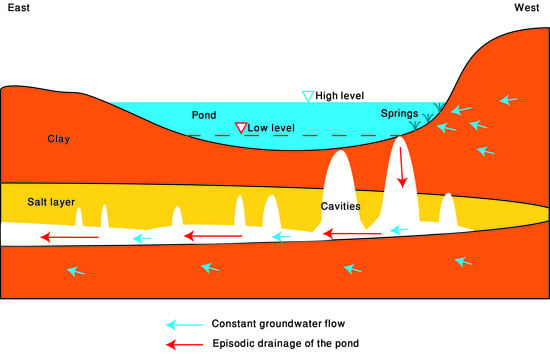Drainage Mechanisms of Submerged Sinkholes
Abstract
:1. Introduction
2. Shalem Sinkhole Site
3. Measurements of Water Level and Topographic Evolution
4. Results
4.1. Water Levels
4.2. Sinkhole Shape and Volume
4.3. Flux Calculations
5. Discussion
6. Conclusions
Author Contributions
Funding
Acknowledgments
Conflicts of Interest
References
- Martinez, J.D.; Johnson, K.S.; Neal, J.T. Sinkholes in Evaporite Rocks: Surface Subsidence Can Develop within a Matter of Days When Highly Soluble Rocks Dissolve Because of Either Natural or Human Causes. Am. Sci. 1998, 86, 38–51. [Google Scholar] [CrossRef]
- Gutiérrez, F.; Cooper, A.H. Evaporite Dissolution Subsidence in the Historical City of Calatayud, Spain: Damage Appraisal and Prevention. Nat. Hazards 2002, 25, 259–288. [Google Scholar] [CrossRef]
- Waltham, T.; Bell, F.G.; Culshaw, M.G.; Knez, M.; Slabe, T. Sinkholes and Subsidence: Karst and Cavernous Rocks in Engineering and Construction; Springer: Berlin/Heidelberg, Germany, 2005; Volume 382. [Google Scholar]
- Shalev, E.; Lyakhovsky, V. Viscoelastic Damage Modeling of Sinkhole Formation. J. Struct. Geol. 2012, 42, 163–170. [Google Scholar] [CrossRef]
- Abelson, M.; Yechieli, Y.; Crouvi, O.; Baer, G.; Wachs, D.; Bein, A.; Shtivelman, V. Evolution of the Dead Sea Sinkholes. In New Frontiers in Dead Sea Paleoenvironmental Research; Enzel, Y., Agnon, A., Stein, M., Eds.; Geological Society of America: Boulder, CO, USA, 2006; Volume 401, ISBN 9780813724010. [Google Scholar]
- Abou Karaki, N.; Fiaschi, S.; Paenen, K.; Al-Awabdeh, M.; Closson, D. Exposure of Tourism Development to Salt Karst Hazards along the Jordanian Dead Sea Shore. Hydrol. Earth Syst. Sci. 2019, 23, 2111–2127. [Google Scholar] [CrossRef]
- Sevil, J.; Gutiérrez, F. Morphometry and Evolution of Sinkholes on the Western Shore of the Dead Sea. Implications for Susceptibility Assessment. Geomorphology 2023, 434, 108732. [Google Scholar] [CrossRef]
- Baer, G.; Schattner, U.; Wachs, D.; Sandwell, D.; Wdowinski, S.; Frydman, S. The Lowest Place on Earth Is Subsiding—An InSAR (Interferometric Synthetic Aperture Radar) Perspective. GSA Bull. 2002, 114, 12–23. [Google Scholar] [CrossRef]
- Closson, D.; Abou Karaki, N. Human-Induced Geological Hazards along the Dead Sea Coast. Environ. Geol. 2009, 58, 371–380. [Google Scholar] [CrossRef]
- Yechieli, Y.; Abelson, M.; Baer, G. Sinkhole Formation and Subsidence along the Dead Sea Coast, Israel. Hydrogeol. J. 2016, 24, 601–612. [Google Scholar] [CrossRef]
- Nof, R.N.; Abelson, M.; Raz, E.; Magen, Y.; Atzori, S.; Salvi, S.; Baer, G. SAR Interferometry for Sinkhole Early Warning and Susceptibility Assessment along the Dead Sea, Israel. Remote Sens. 2019, 11, 89. [Google Scholar] [CrossRef]
- Al-Halbouni, D.; Watson, R.A.; Holohan, E.P.; Meyer, R.; Polom, U.; Dos Santos, F.M.; Comas, X.; Alrshdan, H.; Krawczyk, C.M.; Dahm, T. Dynamics of Hydrological and Geomorphological Processes in Evaporite Karst at the Eastern Dead Sea—A Multidisciplinary Study. Hydrol. Earth Syst. Sci. 2021, 25, 3351–3395. [Google Scholar] [CrossRef]
- Al-Halbouni, D.; Holohan, E.P.; Saberi, L.; Alrshdan, H.; Sawarieh, A.; Closson, D.; Walter, T.R.; Dahm, T. Sinkholes, Subsidence and Subrosion on the Eastern Shore of the Dead Sea as Revealed by a Close-Range Photogrammetric Survey. Geomorphology 2017, 285, 305–324. [Google Scholar] [CrossRef]
- Baer, G.; Magen, Y.; Nof, R.N.; Raz, E.; Lyakhovsky, V.; Shalev, E. InSAR Measurements and Viscoelastic Modeling of Sinkhole Precursory Subsidence: Implications for Sinkhole Formation, Early Warning, and Sediment Properties. J. Geophys. Res. Earth Surf. 2018, 123, 678–693. [Google Scholar] [CrossRef]
- Gertman, I.; Hecht, A. The Dead Sea Hydrography from 1992 to 2000. J. Mar. Syst. 2002, 35, 169–181. [Google Scholar] [CrossRef]
- Yechieli, Y.; Abelson, M.; Bein, A.; Crouvi, O.; Shtivelman, V. Sinkhole “Swarms” along the Dead Sea Coast: Reflection of Disturbance of Lake and Adjacent Groundwater Systems. GSA Bull. 2006, 118, 1075–1087. [Google Scholar] [CrossRef]
- Frumkin, A.; Ezersky, M.; Al-Zoubi, A.; Akkawi, E.; Abueladas, A.-R. The Dead Sea Sinkhole Hazard: Geophysical Assessment of Salt Dissolution and Collapse. Geomorphology 2011, 134, 102–117. [Google Scholar] [CrossRef]
- Gutiérrez, F.; Guerrero, J.; Lucha, P. A Genetic Classification of Sinkholes Illustrated from Evaporite Paleokarst Exposures in Spain. Environ. Geol. 2008, 53, 993–1006. [Google Scholar] [CrossRef]
- Shalev, E.; Lyakhovsky, V.; Yechieli, Y. Salt Dissolution and Sinkhole Formation along the Dead Sea Shore. J. Geophys. Res. Solid Earth 2006, 111. [Google Scholar] [CrossRef]
- Sagy, A.; Reches, Z.; Agnon, A. Hierarchic Three-Dimensional Structure and Slip Partitioning in the Western Dead Sea Pull-Apart. Tectonics 2003, 22. [Google Scholar] [CrossRef]
- Watson, R.A.; Holohan, E.P.; Al-Halbouni, D.; Saberi, L.; Sawarieh, A.; Closson, D.; Alrshdan, H.; Abou Karaki, N.; Siebert, C.; Walter, T.R.; et al. Sinkholes and Uvalas in Evaporite Karst: Spatio-Temporal Development with Links to Base-Level Fall on the Eastern Shore of the Dead Sea. Solid Earth 2019, 10, 1451–1468. [Google Scholar] [CrossRef]
- Salvati, R.; Sasowsky, I.D. Development of Collapse Sinkholes in Areas of Groundwater Discharge. J. Hydrol. 2002, 264, 1–11. [Google Scholar] [CrossRef]
- Tuccimei, P.; Salvati, R.; Capelli, G.; Delitala, M.C.; Primavera, P. Groundwater Fluxes into a Submerged Sinkhole Area, Central Italy, Using Radon and Water Chemistry. Appl. Geochem. 2005, 20, 1831–1847. [Google Scholar] [CrossRef]
- Yakar, M. Using close range photogrammetry to measure the position of inaccessible geological features. Exp. Tech. 2011, 35, 54–59. [Google Scholar] [CrossRef]
- Canaz Sevgen, S. Airborne Lidar Data Classification in Complex Urban Area Using Random Forest: A Case Study of Bergama, Turkey. Int. J. Eng. Geosci. 2019, 4, 45–51. [Google Scholar] [CrossRef]
- Sanchez Diaz, B.; Mata-Zayas, E.E.; Gama-Campillo, L.M.; Rincon-Ramirez, J.A.; Vidal-Garcia, F.; Rullan-Silva, C.D.; Sanchez-Gutierrez, F. LiDAR Modeling to Determine the Height of Shade Canopy Tree in Cocoa Agrosystems as Available Habitat for Wildlife. Int. J. Eng. Geosci. 2022, 7, 283–293. [Google Scholar] [CrossRef]
- Cetin, Z.; Yastikli, N. Automatic Detection of Single Street Trees from Airborne LiDAR Data Based on Point Segmentation Methods. Int. J. Eng. Geosci. 2022, 8, 129–137. [Google Scholar] [CrossRef]

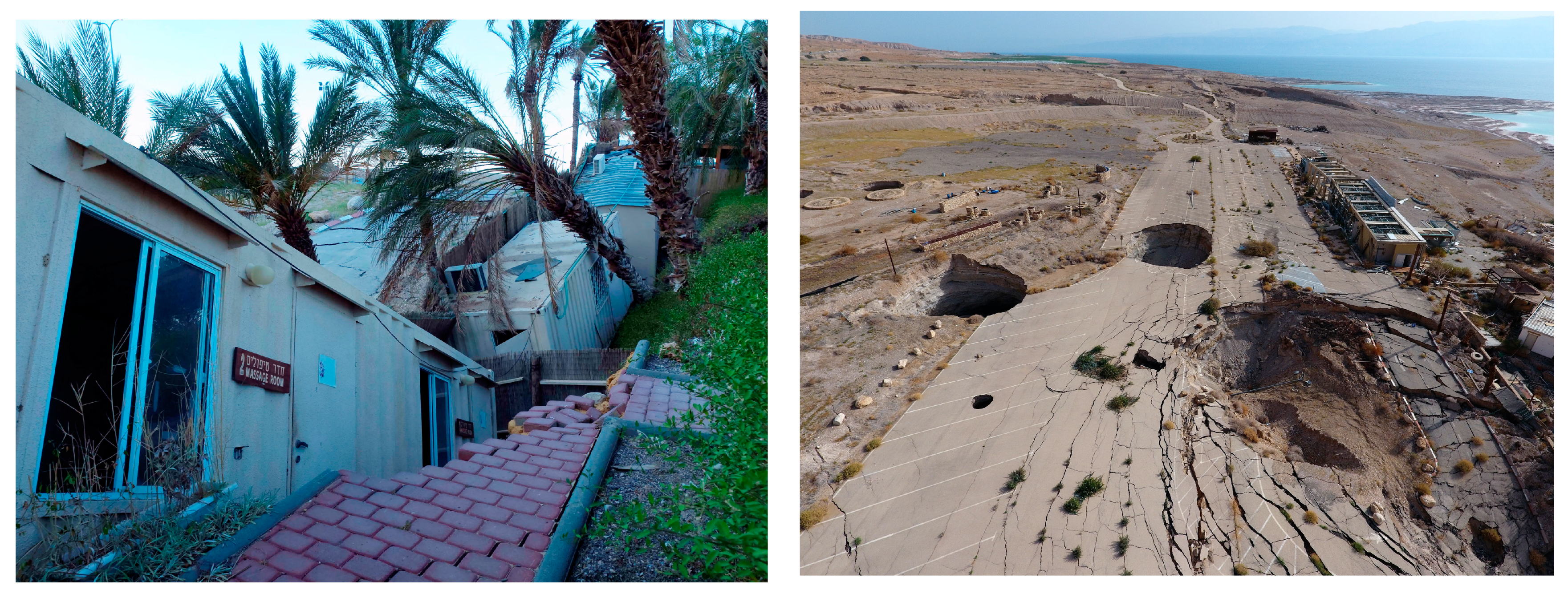
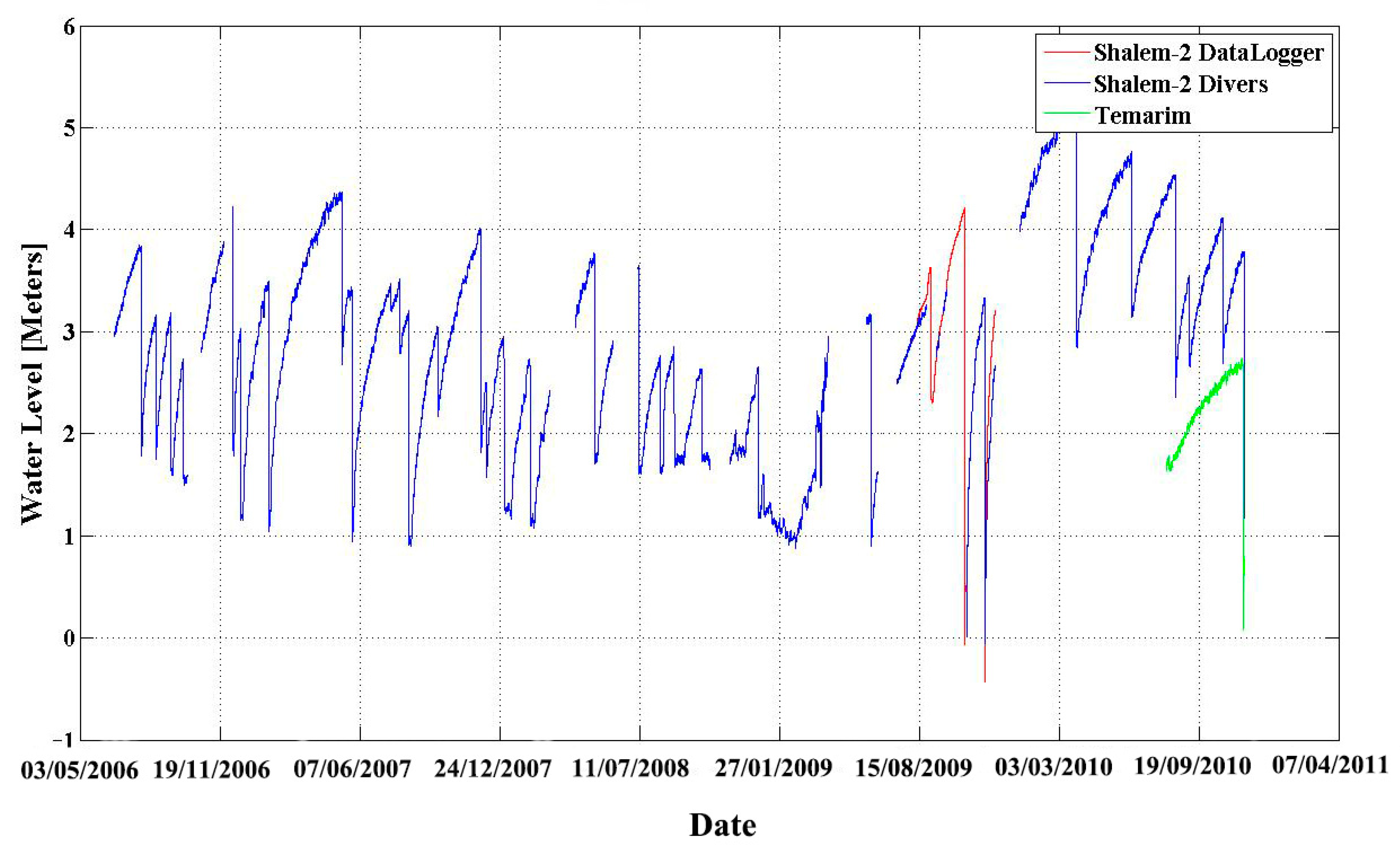
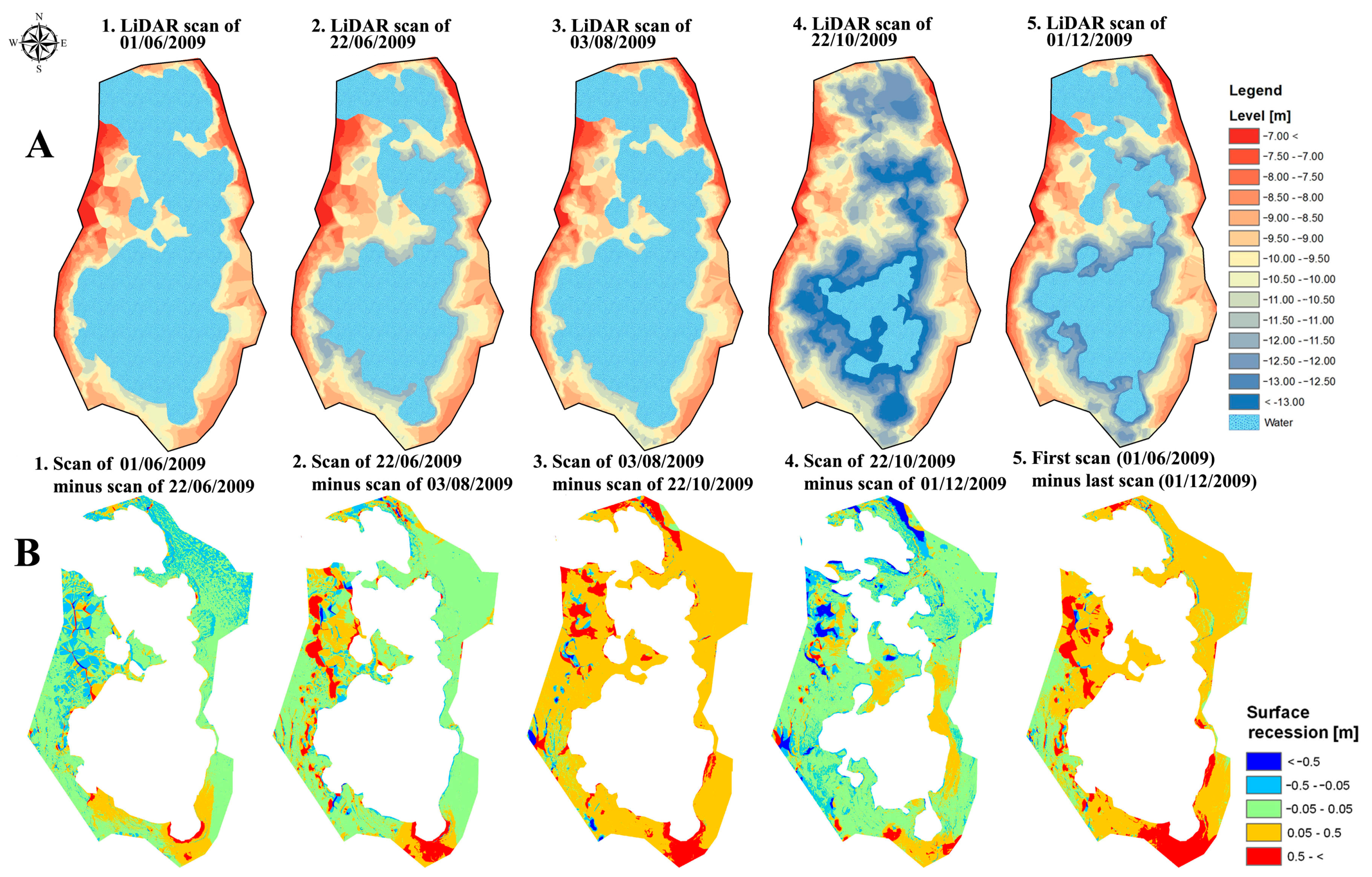
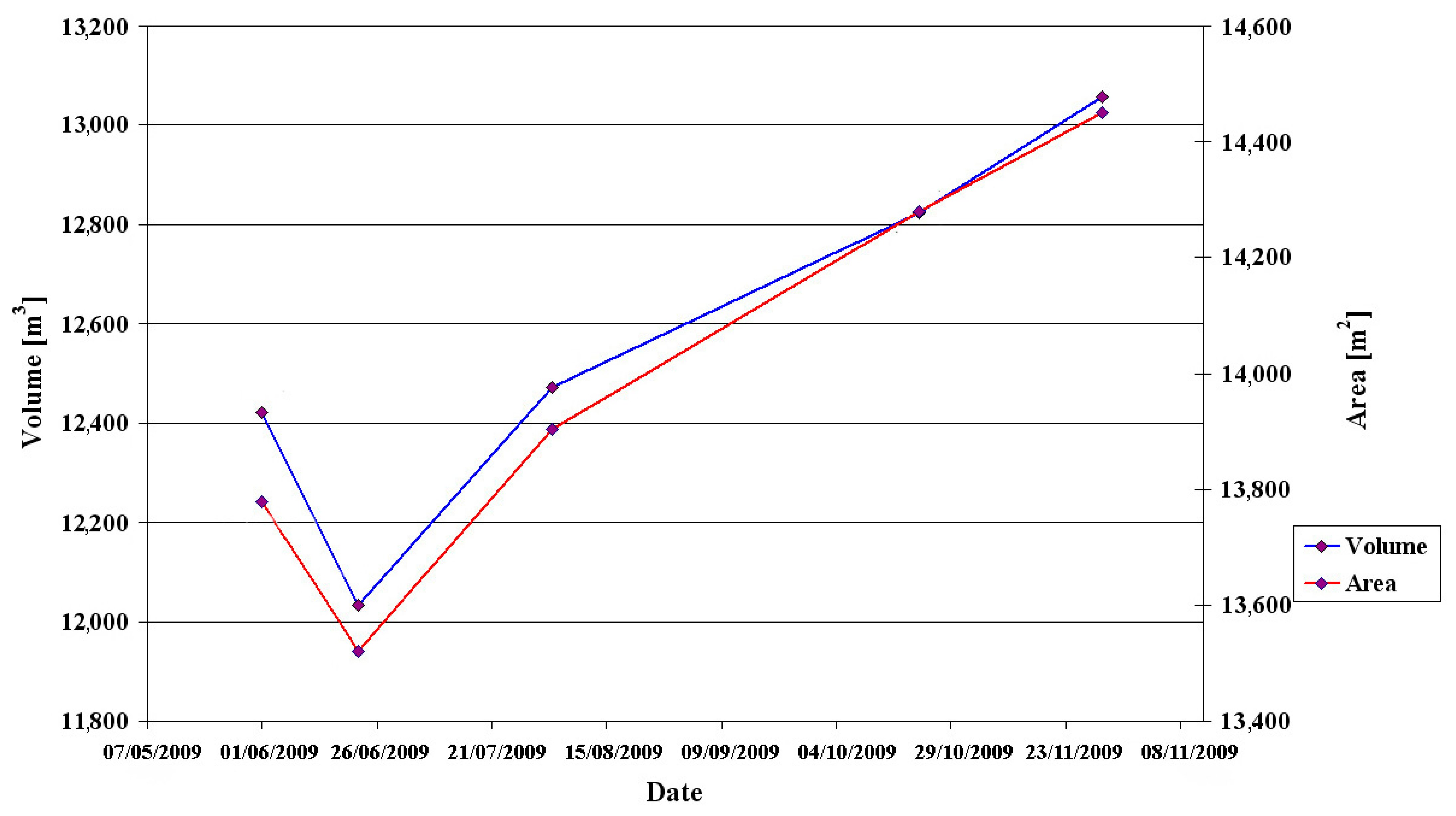

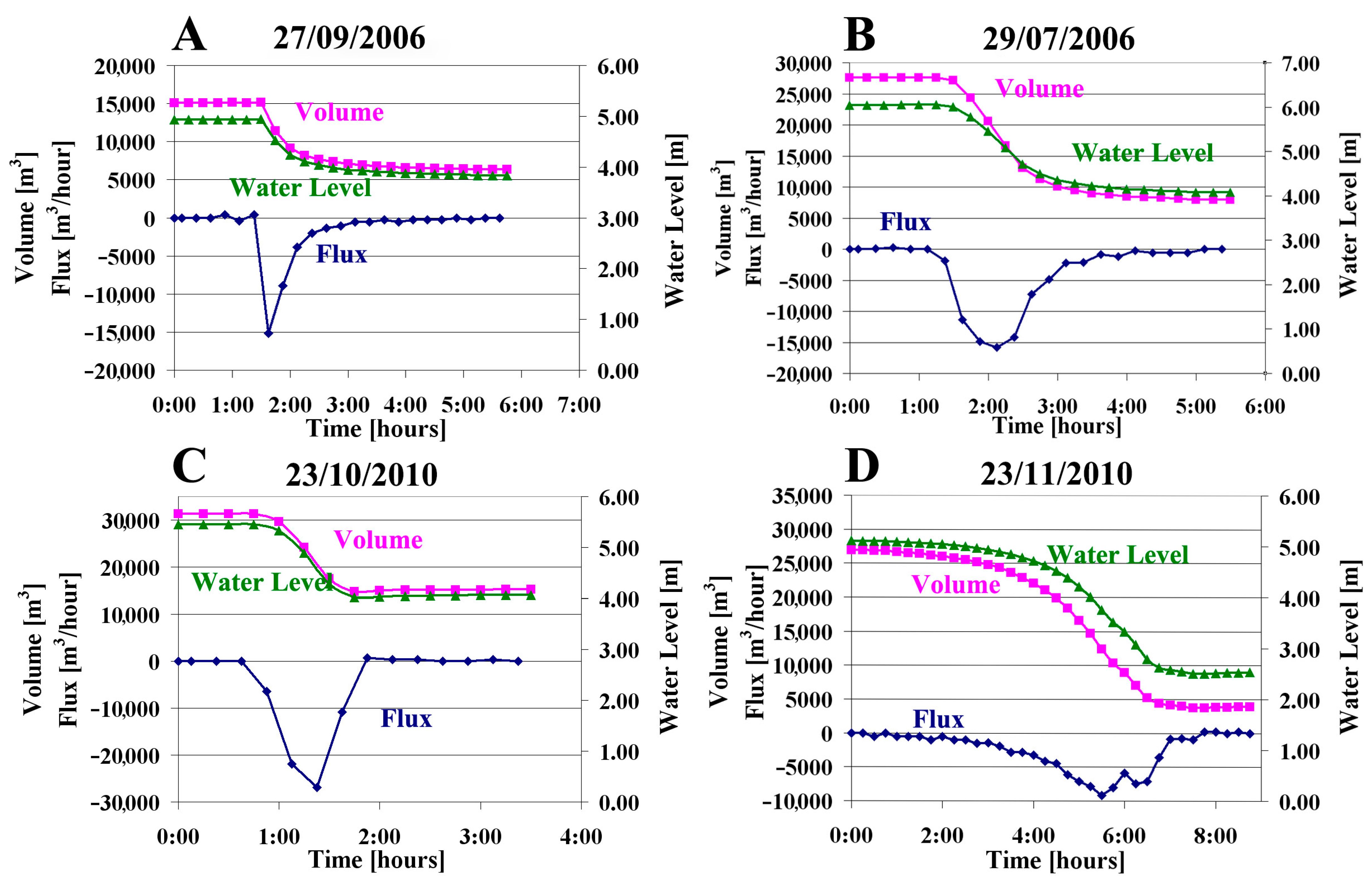
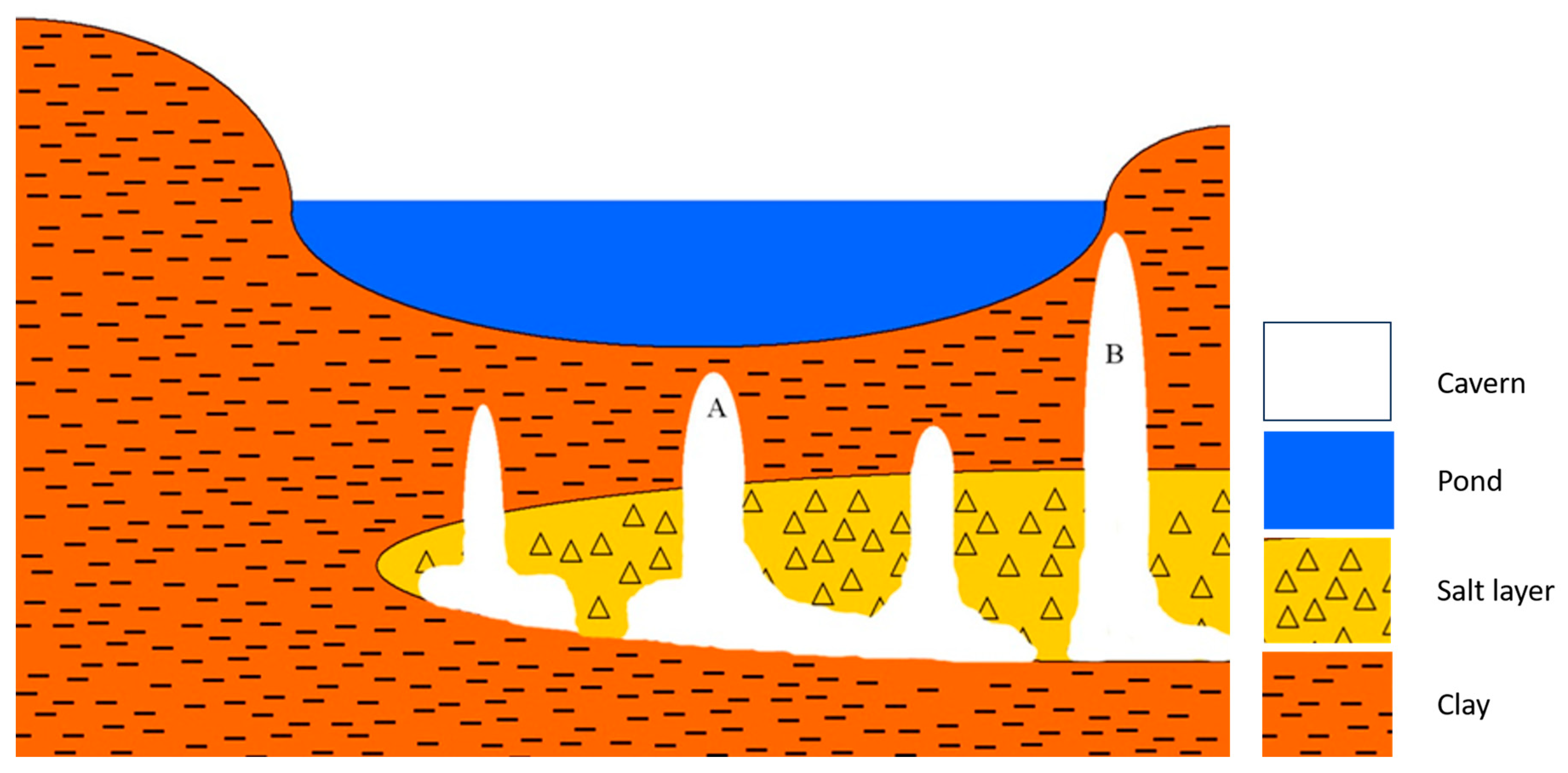
| Date of Event | Time from Previous Event [Days] | Event Duration [hh:mm] | Level at Start [m] | Level at End | Level Dropped | Volume at Start [m3] | Volume at End [m3] | Volume Drained Out [m3] | Maximum Flux [m3/h] |
|---|---|---|---|---|---|---|---|---|---|
| 29/07/2006 | 03:00 | 6.05 | 4.01 | 2.04 | 27,640 | 7972 | 19,668 | 15,844 | |
| 19/08/2006 | 21 | 03:30 | 5.37 | 3.95 | 1.42 | 19,620 | 7830 | 11,790 | 9832 |
| 10/09/2006 | 21 | 04:00 | 5.4 | 3.84 | 1.56 | 19,950 | 6535 | 13,415 | 11,692 |
| 27/09/2006 | 17 | 02:00 | 4.94 | 3.77 | 1.17 | 15,170 | 5959 | 9211 | 15,172 |
| 08/12/2006 | 73 | 04:15 | 6.44 | 3.99 | 2.45 | 32,880 | 7341 | 25,539 | 16,296 |
| 19/12/2006 | 11 | 03:00 | 5.22 | 3.35 | 1.87 | 18,110 | 3654 | 14,456 | 12,712 |
| 28/01/2007 (1) | 40 | 05:15 | 5.68 | 4.57 | 1.11 | 23,150 | 11,890 | 11,260 | 6460 |
| 28/01/2007 (2) | 0.5 | 02:15 | 4.58 | 3.25 | 1.33 | 11,970 | 3145 | 8825 | 6708 |
| 12/05/2007 | 104 | 11:45 | 6.58 | 4.88 | 1.7 | 34,870 | 14,790 | 20,080 | 4492 |
| 26/05/2007 | 14 | 02:45 | 5.62 | 3.22 | 2.4 | 22,450 | 3056 | 19,394 | 16,060 |
| 22/07/2007 | 57 | 01:45 | 5.65 | 5.42 | 0.23 | 22,800 | 20,170 | 2630 | 2768 |
| 03/08/2007 | 12 | 04:00 | 5.66 | 5 | 0.66 | 23,030 | 15,760 | 7270 | 4624 |
| 16/08/2007 | 13 | 02:15 | 5.39 | 3.12 | 2.27 | 19,950 | 2625 | 17,325 | 12,728 |
| 26/09/2007 | 41 | 07:00 | 5.23 | 4.38 | 0.85 | 18,220 | 10,230 | 7990 | 2844 |
| 27/11/2007 | 62 | 06:15 | 6.21 | 4.03 | 2.18 | 29,800 | 7901 | 21,899 | 19,932 |
| 04/12/2007 | 7 | 07:00 | 4.69 | 3.78 | 0.91 | 12,940 | 5959 | 6981 | 3380 |
| 30/12/2007 | 26 | 07:00 | 5.16 | 3.42 | 1.74 | 17,380 | 4551 | 12,829 | 5208 |
| 05/02/2008 | 6 | 02:45 | 4.87 | 3.36 | 1.51 | 14,590 | 3654 | 10,936 | 8488 |
| 08/05/2008 | 61 | 02:45 | 5.95 | 3.92 | 2.03 | 26,430 | 6866 | 19,564 | 21,420 |
| 10/07/2008 | 63 | 01:15 | 5.86 | 3.87 | 1.99 | 25,310 | 6601 | 18,709 | 29,160 |
| 09/08/2008 | 30 | 01:15 | 4.98 | 3.83 | 1.15 | 15,560 | 6276 | 9284 | 13,172 |
| 29/08/2008 | 20 | 05:45 | 5.05 | 3.94 | 1.11 | 16,250 | 6933 | 9317 | 3044 |
| 07/10/2008 | 39 | 01:00 | 4.84 | 3.94 | 0.9 | 14,220 | 7000 | 7220 | 14,976 |
| 26/11/2008 | 50 | 01:00 | 4.22 | 4.01 | 0.21 | 8996 | 7549 | 1447 | 2840 |
| 28/12/2008 | 32 | 03:15 | 4.82 | 3.38 | 1.44 | 14,120 | 3749 | 10,371 | 8488 |
| 04/01/2009 | 7 | 02:00 | 3.79 | 3.44 | 0.35 | 6021 | 3992 | 2029 | 2340 |
| 21–24/03/2008 | 78 | ||||||||
| 07/06/2009 | 45 | 01:45 | 5.33 | 3.11 | 2.22 | 19,180 | 2542 | 16,638 | 18,192 |
| 31/08/2009 | 85 | 13:30 | 5.95 | 4.63 | 1.32 | 23,365 | 11,489 | 11,876 | 4944 |
| 19/10/2009 | 49 | 01:51 | 6.53 | 2.26 | 4.27 | 32,636 | −100 | 32,736 | 30,948 |
| 16/11/2009 | 28 | 03:00 | 4.65 | 1.35 | 3.3 | 21,410 | 132 | 21,278 | 19,584 |
| 28/03/2010 | 132 | 03:25 | 6.63 | 4.19 | 2.43 | 49,220 | 17,070 | 32,150 | 24,564 |
| 15/06/2010 | 79 | 03:30 | 6.06 | 4.47 | 1.59 | 40,190 | 19,400 | 20,790 | 17,310 |
| 16/08/2010 | 62 | 03:15 | 5.87 | 3.7 | 2.17 | 37,160 | 11,800 | 25,360 | 17,236 |
| 05/09/2010 | 20 | 02:15 | 4.87 | 3.99 | 0.88 | 23,980 | 14,500 | 9480 | 14,644 |
| 23/10/2010 | 48 | 01:15 | 5.45 | 4.02 | 1.43 | 31,300 | 14,790 | 16,510 | 26,940 |
| 23/11/2010 | 31 | 07:00 | 5.11 | 2.5 | 2.61 | 27,060 | 3749 | 23,311 | 9140 |
| Minimum (Yellow) | 1 | 01:00 | 3.79 | 1.35 | 0.21 | 6021 | −100 | 1447 | 2340 |
| Maximum (Red) | 132 | 13:30 | 6.63 | 5.42 | 4.27 | 49,220 | 20,170 | 32,736 | 30,948 |
| Average | 41.25 | 03:51 | 5.41 | 3.77 | 1.63 | 22,692 | 7982 | 14,710 | 12,616 |
Disclaimer/Publisher’s Note: The statements, opinions and data contained in all publications are solely those of the individual author(s) and contributor(s) and not of MDPI and/or the editor(s). MDPI and/or the editor(s) disclaim responsibility for any injury to people or property resulting from any ideas, methods, instructions or products referred to in the content. |
© 2023 by the authors. Licensee MDPI, Basel, Switzerland. This article is an open access article distributed under the terms and conditions of the Creative Commons Attribution (CC BY) license (https://creativecommons.org/licenses/by/4.0/).
Share and Cite
Tsabar, A.; Shalev, E.; Sagy, A.; Makovsky, Y. Drainage Mechanisms of Submerged Sinkholes. Remote Sens. 2023, 15, 4384. https://doi.org/10.3390/rs15184384
Tsabar A, Shalev E, Sagy A, Makovsky Y. Drainage Mechanisms of Submerged Sinkholes. Remote Sensing. 2023; 15(18):4384. https://doi.org/10.3390/rs15184384
Chicago/Turabian StyleTsabar, Assaf, Eyal Shalev, Amir Sagy, and Yizhaq Makovsky. 2023. "Drainage Mechanisms of Submerged Sinkholes" Remote Sensing 15, no. 18: 4384. https://doi.org/10.3390/rs15184384
APA StyleTsabar, A., Shalev, E., Sagy, A., & Makovsky, Y. (2023). Drainage Mechanisms of Submerged Sinkholes. Remote Sensing, 15(18), 4384. https://doi.org/10.3390/rs15184384








